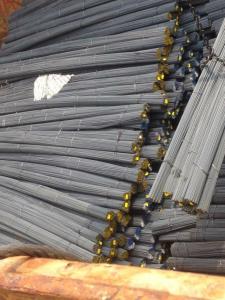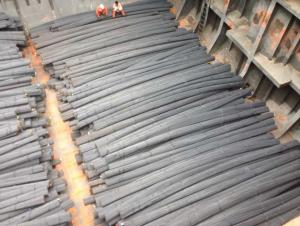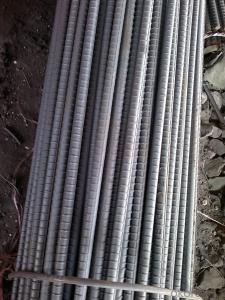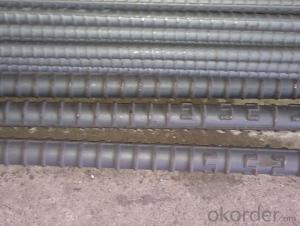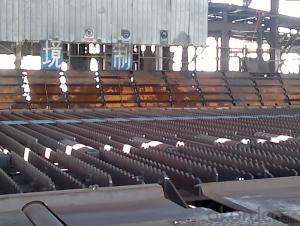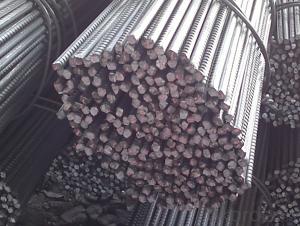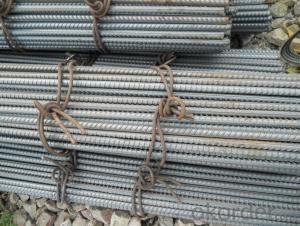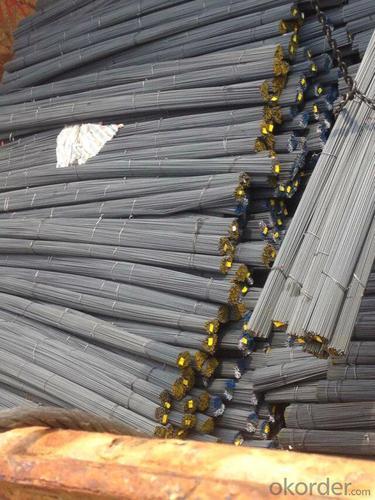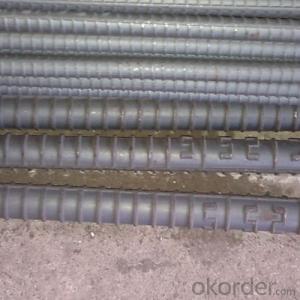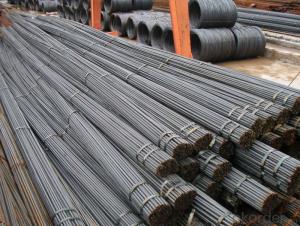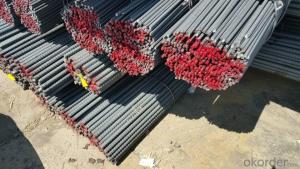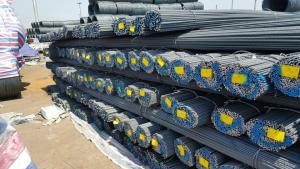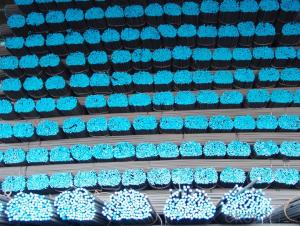Deformed Steel Bar HRB400
- Loading Port:
- China Main Port
- Payment Terms:
- TT or LC
- Min Order Qty:
- -
- Supply Capability:
- -
OKorder Service Pledge
OKorder Financial Service
You Might Also Like
Product Description:
OKorder is offering Deformed Steel Bar HRB400 at great prices with worldwide shipping. Our supplier is a world-class manufacturer of steel, with our products utilized the world over. OKorder annually supplies products to European, North American and Asian markets. We provide quotations within 24 hours of receiving an inquiry and guarantee competitive prices.
Standard | GB | HRB400 | |
Diameter | 6mm,8mm,10mm,12mm,14mm,16mm,18mm,20mm, 22mm,25mm,28mm,32mm,36mm,40mm,50mm | ||
Length | 6M, 9M,12M or as required | ||
Place of origin | Hebei, China mainland | ||
Advantages | exact size, regular package, chemical and mechanical properties are stable. | ||
Type | Hot rolled deformed steel bar | ||
Brand name | DRAGON | ||
Chemical Composition: (Please kindly find our chemistry of our material based on HRB500 as below for your information)
Grade | Technical data of the original chemical composition (%) | ||||||
C | Mn | Si | S | P | V | ||
HRB400 | ≤0.25 | ≤1.60 | ≤0.80 | ≤0.045 | ≤0.045 | 0.04-0.12 | |
Physical capability | |||||||
Yield Strength (N/cm²) | Tensile Strength (N/cm²) | Elongation (%) | |||||
≥400 | ≥570 | ≥14 | |||||
Theoretical weight and section area of each diameter as below for your information:
Diameter(mm) | Section area (mm²) | Mass(kg/m) | Weight of 12m bar(kg) |
6 | 28.27 | 0.222 | 2.664 |
8 | 50.27 | 0.395 | 4.74 |
10 | 78.54 | 0.617 | 7.404 |
12 | 113.1 | 0.888 | 10.656 |
14 | 153.9 | 1.21 | 14.52 |
16 | 201.1 | 1.58 | 18.96 |
18 | 254.5 | 2.00 | 24 |
20 | 314.2 | 2.47 | 29.64 |
22 | 380.1 | 2.98 | 35.76 |
25 | 490.9 | 3.85 | 46.2 |
28 | 615.8 | 4.83 | 57.96 |
32 | 804.2 | 6.31 | 75.72 |
36 | 1018 | 7.99 | 98.88 |
40 | 1257 | 9.87 | 118.44 |
50 | 1964 | 15.42 | 185.04 |
Deformed bar is widely used in buildings, bridges, roads and other engineering construction. Big to highways, railways, bridges, culverts, tunnels, public facilities such as flood control, dam, small to housing construction, beam, column, wall and the foundation of the plate, deformed bar is an integral structure material. With the development of world economy and the vigorous development of infrastructure construction, real estate, the demand for deformed bar will be larger and larger..
Packaging Detail: products are packed in bundle and then shipped by container or bulk vessel, deformed bar is usually naked strapping delivery, when storing, please pay attention to moisture proof. The performance of rust will produce adverse effect.
Each bundle weight: 2-3MT, or as required
Product Applications:
Deformed Steel Bar HRB400 are ideal for structural applications and are widely used in the construction of buildings and bridges, and the manufacturing, petrochemical, and transportation industries.
Product Advantages:
OKorder's Deformed Steel Bar HRB400 are durable, strong, and resist corrosion.
Main Product Features:
· Premium quality
· Prompt delivery & seaworthy packing (30 days after receiving deposit)
· Corrosion resistance
· Can be recycled and reused
· Mill test certification
Product Specifications:
Standard: GB
Material: Q235
Origin place: China
FAQ:
Q1: Can stainless steel rust?
A1: Stainless does not "rust" as you think of regular steel rusting with a red oxide on the surface that flakes off. If you see red rust it is probably due to some iron particles that have contaminated the surface of the stainless steel and it is these iron particles that are rusting. Look at the source of the rusting and see if you can remove it from the surface.
Q2: How do we guarantee the quality of our products?
A2: We have established an advanced quality management system which conducts strict quality tests at every step, from raw materials to the final product. At the same time, we provide extensive follow-up service assurances as required.
Q3: How soon can we receive the product after purchase?
A3: Within three days of placing an order, we will begin production. The specific shipping date is dependent upon international and government factors, but is typically 7 to 10 workdays.
bdenum enhance this surface layer and improve the corrosion resistance of the stainless material.
Images:
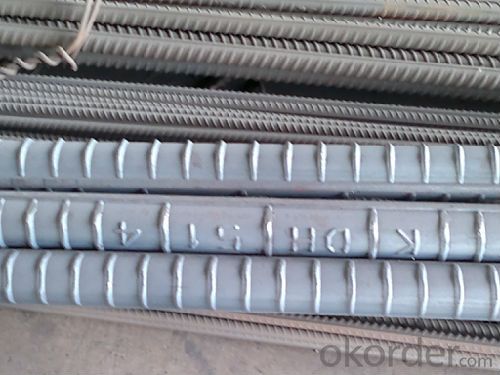
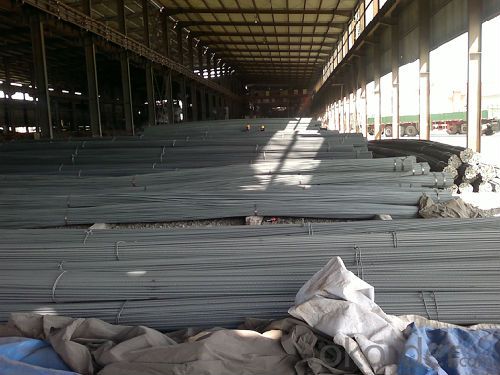
- Q: Can steel rebars be used in structures with high electromagnetic shielding requirements?
- Yes, steel rebars can be used in structures with high electromagnetic shielding requirements. Steel is a highly conductive material, which means it can effectively block electromagnetic waves. Therefore, when properly installed and grounded, steel rebars can provide significant electromagnetic shielding for structures.
- Q: What is the impact of steel rebars on the overall energy efficiency of a building?
- The impact of steel rebars on the overall energy efficiency of a building is relatively minimal. While steel rebars are commonly used in construction to reinforce concrete structures, they do not directly affect the energy efficiency of a building. Energy efficiency factors such as insulation, windows, HVAC systems, and renewable energy sources play a more significant role in reducing energy consumption. However, the selection of an appropriate steel rebar type and size can contribute to the structural integrity of the building, ensuring its durability and longevity, which indirectly contributes to sustainability and resource conservation.
- Q: What is the process of bending steel rebars?
- The process of bending steel rebars typically involves using a specialized machine called a rebar bender. The rebars, which are long, thin rods made of steel, are positioned on the bender machine and clamped securely. The operator then uses the machine's controls to apply force and gradually bend the rebar to the desired angle or shape. The bending process requires precision and may involve multiple bends depending on the specific project requirements.
- Q: What are the guidelines for the proper installation of steel rebars?
- Achieving the structural integrity and durability of reinforced concrete structures relies heavily on the correct installation of steel rebars. To ensure their proper installation, the following guidelines must be followed: 1. Planning and Design: Prior to commencing installation, a detailed plan and design must be established. This involves determining the necessary rebar size, spacing, and configuration based on structural requirements and specifications. It is crucial to consult with structural engineers and adhere to local building codes and regulations. 2. Cutting and Bending: Rebars should be accurately cut and bent in accordance with the design specifications. The use of appropriate tools, such as rebar cutters and benders, is necessary to achieve clean cuts and precise bends. Any rebars that are damaged or corroded should be discarded and replaced. 3. Cleaning and Preparation: The surface of the rebars should be free from contaminants such as rust, oil, dirt, or loose scales before installation. The recommended method for cleaning rebars is using wire brushes or air blasting to ensure proper adhesion between the rebar and concrete. 4. Placement and Positioning: Rebars should be placed and positioned accurately based on the design drawings. They should be securely tied or supported using tie wires or rebar chairs to maintain the desired spacing and alignment. Splices should be made according to the design requirements and properly lapped to ensure continuity and strength. 5. Concrete Cover: Adequate concrete cover is crucial to protect the rebars from corrosion and provide fire resistance. The concrete cover thickness should meet the design specifications and local building codes. Proper spacing between rebars and formwork should be maintained to allow for proper concrete flow and consolidation. 6. Anchorage and Embedment: Sufficient anchorage and embedment of rebars are essential for load transfer and structural stability. Special attention should be given to providing proper hooks, bends, or mechanical anchorage at the ends of rebars as required by the design. The rebars should be appropriately embedded into adjacent concrete elements to achieve the desired bond strength. 7. Inspection and Quality Control: Regular inspection should be conducted throughout the installation process to ensure compliance with design specifications and quality standards. Any deviations or defects should be promptly identified and rectified. It is important to document the installation process and maintain proper records for future reference. By adhering to these guidelines, the proper installation of steel rebars can be accomplished, guaranteeing the structural strength, longevity, and safety of reinforced concrete structures.
- Q: Can steel rebars be cut to custom lengths?
- Yes, steel rebars can be cut to custom lengths. Rebars are typically available in standard lengths, but they can be easily cut to fit specific project requirements. This can be done using various tools such as an angle grinder, cutting torch, or a hydraulic rebar cutter. It is important to use proper safety measures and techniques when cutting steel rebars to ensure accurate cuts and prevent any accidents or injuries.
- Q: Can steel rebars be used in road and bridge construction?
- Yes, steel rebars can be used in road and bridge construction. Steel rebars are commonly used as reinforcement in concrete structures, including roads and bridges, to provide strength and durability. The rebars are embedded within the concrete to enhance its tensile strength and prevent cracking or structural failure. Steel rebars are preferred in such constructions due to their high strength, ductility, and resistance to corrosion. They help to distribute loads and stresses evenly, making the structures more resilient and capable of withstanding heavy traffic and environmental conditions. Additionally, steel rebars can be easily fabricated and customized to meet the specific design requirements of road and bridge construction projects.
- Q: How do steel rebars prevent concrete structures from collapsing?
- Reinforcement and strength are provided to concrete structures by steel rebars, which prevent their collapse. Concrete is capable of withstanding forces that compress or squeeze it, making it a strong material. However, it is not able to withstand forces that pull it apart, resulting in weakness in tension. When subjected to tension, concrete may crack and ultimately fail. To counteract these tensile forces and offer additional strength, reinforcement bars, also known as steel rebars, are typically embedded within concrete structures. These rebars are made of high-strength steel and are strategically placed to resist the pulling forces. When external forces, such as wind or seismic activity, impact a concrete structure, the rebars assist in distributing the load and resisting tension. As the concrete attempts to separate, the rebars hold it together, preventing the propagation of cracks and maintaining the structure's integrity. Additionally, the rebars enhance the overall durability and lifespan of the concrete structure. By reinforcing the concrete, they mitigate the effects of shrinkage and thermal expansion, which can lead to cracks over time. Consequently, a more stable and resilient structure is achieved, capable of withstanding various environmental and structural stresses. In conclusion, steel rebars are crucial in averting the collapse of concrete structures, as they provide the necessary reinforcement and strength to resist tension. They elevate the structural integrity, durability, and safety of concrete structures, ensuring their ability to withstand demands and fulfill their intended purpose for extended periods.
- Q: How are steel rebars protected from concrete spalling?
- Various methods and techniques are utilized to safeguard steel rebars from concrete spalling. One commonly employed approach involves the application of a concrete cover over the rebars. This entails embedding the rebars within the concrete structure to prevent direct exposure to external elements or conditions that may lead to spalling. To ensure adequate protection, construction codes and standards typically prescribe the thickness of the concrete cover. Another means of shielding steel rebars from concrete spalling is the use of corrosion inhibitors. These inhibitors are typically incorporated into the concrete mix during construction. They function by reducing the rate of corrosion for the steel rebars, effectively safeguarding them against spalling caused by rusting and corrosion. In addition to concrete cover and corrosion inhibitors, proper concrete mix design holds significant importance in protecting steel rebars. The utilization of high-quality concrete with an appropriate water-cement ratio, adequate strength, and suitable curing greatly enhances the concrete's resistance against spalling. This guarantees the secure embedding of the rebars within the concrete structure and shields them from moisture or other deteriorating agents that could lead to spalling. Furthermore, adhering to proper construction practices, such as thorough compaction of concrete, precise placement and alignment of rebars, and effective waterproofing measures, also contribute to the protection of steel rebars from concrete spalling. These practices help minimize the likelihood of moisture ingress and the formation of cracks or voids that could expose the rebars to the risk of spalling. In summary, a combination of concrete cover, corrosion inhibitors, appropriate concrete mix design, and sound construction practices are vital in safeguarding steel rebars from concrete spalling. By implementing these measures, the durability and lifespan of concrete structures can be significantly enhanced.
- Q: How do steel rebars enhance the structural integrity of a building?
- Steel rebars enhance the structural integrity of a building by providing reinforcement and strength to concrete structures. They prevent cracking, bending, and collapsing under heavy loads, seismic activities, and temperature changes, ensuring the stability and durability of the building.
- Q: What is a steel rebar?
- A steel rebar, also known as reinforcing bar, is a long, cylindrical steel rod or bar that is commonly used in construction projects to reinforce concrete structures. It is embedded within the concrete to enhance its strength and durability, providing resistance against tension and preventing cracking and structural failure.
Send your message to us
Deformed Steel Bar HRB400
- Loading Port:
- China Main Port
- Payment Terms:
- TT or LC
- Min Order Qty:
- -
- Supply Capability:
- -
OKorder Service Pledge
OKorder Financial Service
Similar products
Hot products
Hot Searches
Related keywords
